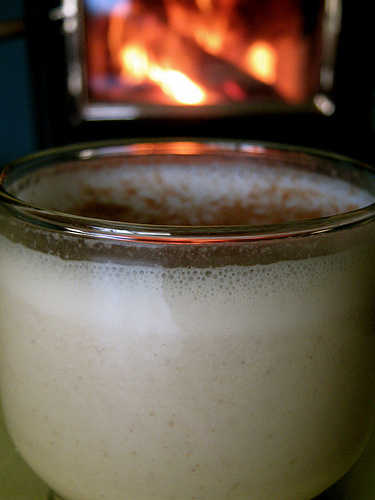 Leave those tacky cartons at the grocery store. Wait ‘till you taste this rich and nutrient dense version of eggnog! This drink will offset any other holiday beverages, which by the way, are not as health supporting.
Leave those tacky cartons at the grocery store. Wait ‘till you taste this rich and nutrient dense version of eggnog! This drink will offset any other holiday beverages, which by the way, are not as health supporting.
What you and your family deserve this Christmas is rich, thick eggnog that’s loaded with live enzymes, nutrient dense vitamins and of course, deliciously good cheer.
The quality of the ingredients add a superb benefit, but are not necessary. Go with the highest quality you can find such as raw, organic milk and cream and free range egg yolks. If the eggs are not free-range, try to have at least organic. Eggs eaten raw should not be conventionally produced.
Here’s what you’ll need:
12 free range eggs
6 cups raw milk
2 cups heavy, raw cream
1/2 cup raw honey (my 1st choice, because of the accompanying raw enzymes, but maple syrup will do, too.)
1-1/2 teaspoons freshly ground nutmeg, plus more for dusting
Here’s what you do:
Submerge the eggs (still in the shell) in a large bowl of very hot water plus a few drops of dish soap. As the water cools; wash and rinse, then wipe the eggs dry.
Separate the egg yolks and place them in a mixer together with the honey and beat for 10 minutes. Refrigerate the egg whites (you’ll need them later). Allow the egg yolk mixture to cool in the refrigerator for up to 8 hours.
30 minutes before you plan to serve, mix the milk into the chilled yolk mixture. If you plan to add brandy, this is the time to stir it in. Along with this, add in 1 -1/2 tsp nutmeg.
On high-speed, in a separate bowl, beat the cream until stiff peaks form.
In yet another bowl, beat the egg whites until you have stiff peaks. Gently fold the egg white mixture into the egg yolk mixture, then fold the cream into the egg mixture.
Ladle into frosted glasses and sprinkle with the remainder of nutmeg. Serves 8 cups.
Oh, yum.
 Wouldn’t you love to give a great gift this Christmas? I have three suggestions this year. They’re homemade and delicious, but don’t worry, that doesn’t mean you’ll be slaving over a hot stove!
Wouldn’t you love to give a great gift this Christmas? I have three suggestions this year. They’re homemade and delicious, but don’t worry, that doesn’t mean you’ll be slaving over a hot stove!
These are easy, but beware.
You’ll want to make a couple extra batches for yourself.
Or how about oranges with chili peppers? There are countless variations. Pour your finished product into clean, glass canning jars and for a personalized touch, make your own labels. Here’s a basic recipe for Cherry Chutney from Sally Fallon’s book, Nourishing Traditions:
4 cups ripe cherries, pitted and quartered
½ teaspoon coriander seeds
½ teaspoon whole cloves
Grated rind and juice of 1 orange
1/8 cup Sucanat
¼ cup whey
2 teaspoons sea salt
½ cup filtered water
Mix cherries with spices and orange rind, place in a quart-sized, wide-mouth mason jar and press down lightly. Mix remaining ingredients and pour into jar, adding more water if necessary to cover the cherries. The top of the chutney should be at least 1 inch below the top of the jar. Cover tightly and keep at room temperature for 2 days before transferring to refrigerator. This should be eaten within 2 months.
Enjoy!
I recently came across an article that described what the original Thanksgiving dinner would have been like. It seemed to look down its long aquiline nose at the simpler fare of 1621, as if our modern smorgasbord actually could boast a superior culinary position. Today, typical meals include lavish, sweet pies made with vegetable oils as folks smear margarines across their white, yeasty, refined rolls. The vaccinated, domesticated, farm raised turkeys sit satiated with nutritionally vacant stuffing…often from a box.
seemed to look down its long aquiline nose at the simpler fare of 1621, as if our modern smorgasbord actually could boast a superior culinary position. Today, typical meals include lavish, sweet pies made with vegetable oils as folks smear margarines across their white, yeasty, refined rolls. The vaccinated, domesticated, farm raised turkeys sit satiated with nutritionally vacant stuffing…often from a box.
Let me take you back to the feast that started it all. I’m grateful that we can imitate that 17th century wisdom and enjoy humble, pilgrim foods, even now, centuries later.
The Pilgrim’s spread would have included organic venison, wild turkey, goose and duck. They had dibs on local seafood and cod, bass, lobster and clams could have been served, too.
Their thanksgiving feast wasn’t infused with white sugars or corn syrup so don’t expect to see bowls filled with cranberry jelly in the shape of the can or bright yellow, sweet corn. Instead, they munched on toothsome flint corn, which the Indians toasted.
Instead of rolls and breads made with from bleached and processed flours, expect to see hearty cornbread and sourdough bread.
Smart moms make these breads to this very day!
Pilgrims hadn’t yet filled their gardens with potatoes, so instead they stewed and boiled their pumpkin with cinnamon, ginger, butter and vinegar. Wholesome vegetables like radishes, carrots, beans, lettuces, parsnips and leaks would have been on their menu, too.
Likely, their seasonal and regional fruits, such as grapes and plums would have made a satisfying tart, seasoned with rosemary and cinnamon.
Yes, their foods were simple. Their foods were safe. They were not finessed and fussed, but they were wholesome, local, organic and smart. Animal fats and proteins were plentiful, tart flavors were added to the bland and their wheat was fermented.
Time may have provided us with convenient kitchen aids like the oven and Cuisinart, but good, nutrient dense, whole foods are not a fad.
Thank God.
May you and your family enjoy a happy and wholesome Thanksgiving.
Love,
With 1 in 133 in the U.S. affected with celiac disease[1], it’s not too surprising that gluten-free diets are popular these days. But people with Celiac’s disease aren’t the only ones who benefit from gluten-free fare. Did you know, it’s been estimated that 97% of Americans who have Celiac’s disease are not diagnosed?[2]
Many people are completely unaware that they have gluten intolerances and end up experiencing years of discomfort (in mild cases) and much worse, in others.
I like to challenge many of my clients to go gluten free for 30 days and find out whether or not gluten is the culprit responsible for their health dilemmas.
Why don’t you take the challenge, too?
In the process, you’ll discover new ways to make old favorites as well as creative alternatives. Perhaps you’ll realize that you’re better off gluten, as many already have.
Let me get you started! Check out my gluten-free pancakes and banana bread recipes. Or how about pizza with an almond flour crust? A simple bread or a festive almond cranberry loaf are good options, too.
[1] http://www.celiac.org/index.php?option=com_content&view=article&id=5&Itemid=11
Children learn many things in the school, don’t they? Math equations, pronouns, sports and games, but the last thing you want them to soak up is a taste for nutritionally vacant and maybe even harmful foods. Cafeteria foods are notoriously unhealthy and gross. (I remember visiting with the head cook at my son’s school and found that nearly every item in the pantry contained MSG.)
Yes, they must go to school, but that doesn’t mean that they can’t learn invaluable lessons from you and their lunch box, too
Here are 5 easy and fun snacks to snuggle in their lunch box:
Check out these and other fun ideas in my audio CD, “Secret Spoonfuls. Confessions of a Sneaky Mom”!
What do I mean by whole foods? I mean pure foods….. Those foods that are not adulterated by pasteurization, homogenization, preservatives, denaturing and manipulative processes.
I mean foods as they are and as God intended. True, there are some methods that we’ve come up with, to enhance beautiful and whole foods, but it’s only to add an extra spark of vitality and never to take it away. I don’t recommend eating any product that’s been so far removed from the original, that there’s practically nothing of the original left in it. Instant mashed potatoes? Dried cheese powders? Breakfast cereals? 1% milk? Abominations, every single one.
Try these 11 ideas instead:
• Make your own calcium-rich Vinegar: Place several eggs (still in the shell) in a canning jar, and cover with raw, unfiltered apple cider vinegar. After a day or so, the shell will have dissolved, discard the eggs, and strain the vinegar through cheese cloth. What you have left is a calcium-rich vinegar, which you can use in cooking and in your next Salad Dressing. Better than any calcium tablets on the market..and free!
• Make your own Salad Dressing. Easy and edifying. Use your calcium-rich vinegar and cold-pressed olive oil. Add some spices, onion powder, Celtic salt and pepper.
• Make your own Bone Stock. This is the easiest way to get calcium. Minimal effort produces a nutrient dense source of gelatin and protein and a delicious start to any soup or grain. Use it for soups, casseroles, sauces and the liquid for cooking your rice, beans and pasta. (Check out my CD, “Secret Spoonfuls” for this and other great recipes)
• Make your own Thick Homemade Crockpot Yogurt. An ancient food, delicious on its own, in smoothies, in dips, or even added to bread recipes. Remember to use whole fat milk.
• Make your own Pickled Cucumbers. Great as a snack, on the go or on the side. Long lasting and packed with healthy enzymes (Check out my CD, “Secret Spoonfuls” for this and other great recipes)
• Make your own Kombucha. Easy to make, refreshing but more importantly, great for you.
• Make your own sweets, like my…Moose Mounds and In-the-freezer-Cookies (Check out my CD, “Secret Spoonfuls” for this and other great recipes). Wait ‘till you taste these
• Make your own Breakfast. Start your day with proteins like eggs and bacon fried in bacon fat (nitrate free and free range, of course!). Try this instead of cereal, toast or bagels.
• Make your own Breakfast Smoothie. (Check out my CD, “Secret Spoonfuls” for this and other great recipes) Fast, delicious and easy.
• Make your own Mayonnaise. Use raw eggs, olive oil, mustard and lemon juices. Avoid soybean, corn, safflower and canola oils and instead use almond oil. Inexpensive, quick, gourmet and nutritious.
• Find your own Dairy Farmer and drink local raw milk! Ask around at Farmer’s Markets and small farms.